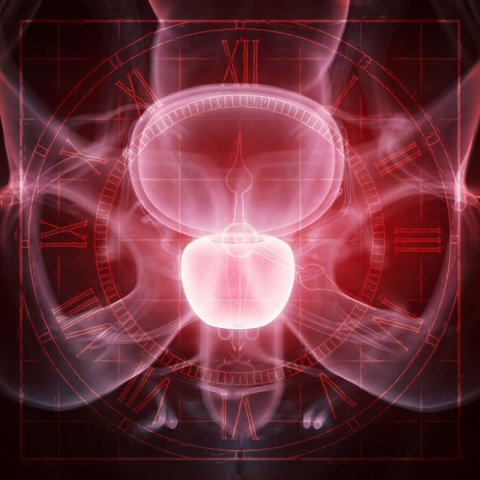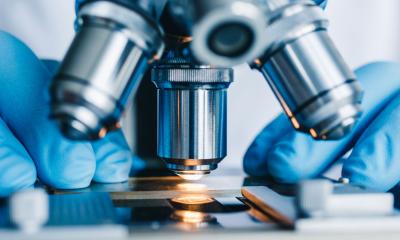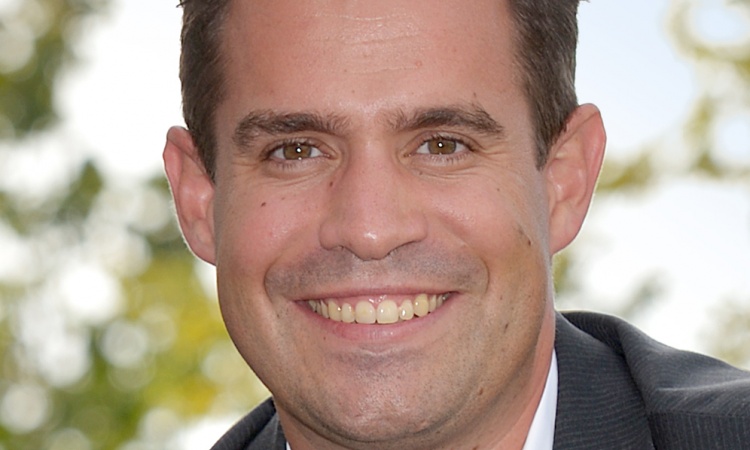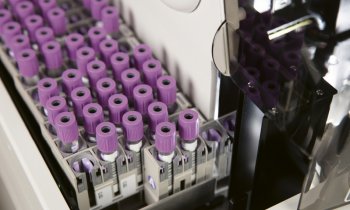News • An unexpected and novel target
How our biological clock could save us from prostate cancer
Our biological or circadian clock synchronizes all our bodily processes to the natural rhythms of light and dark. It’s no wonder then that disrupting the clock can wreak havoc on our body.

Image sources: Shutterstock/SciePro (prostate illustration) / Pixabay/Pete Linforth (clock blueprint)
In fact, studies have shown that when circadian rhythms are disturbed through sleep deprivation, jet lag, or shift work, there is an increased incidence of some cancers including prostate cancer, which is the second leading cause of cancer death for men in the U.S. With an urgent need to develop novel therapeutic targets for prostate cancer, researchers at the Sidney Kimmel Cancer – Jefferson Health (SKCC) explored the circadian clock and found an unexpected role for the clock gene CRY-1 in cancer progression. The study was published in Nature Communications.
“When we analyzed human cancer data, the circadian factor CRY-1 was found to increase in late stage prostate cancers, and is strongly associated with poor outcomes,” explains Karen Knudsen, MBA PhD, executive vice president of oncology services for Jefferson Health and enterprise director of SKCC, and senior author of the study. “However, the role CRY-1 in human cancers has not been explored.”
A common therapy for prostate cancer involves suppressing the male hormone androgen and/or the androgen receptor, as prostate tumors require androgens to develop and progress to advanced disease. With their collaborators in the U.S. and Europe, the researchers found that CRY-1 is induced by the androgen receptor in prostate tumor tissue obtained from patients, thus explaining in part the high levels of CRY-1 observed in human disease. “This was a clear indication of CRY-1’s link to prostate cancer,” says Ayesha Shafi, PhD, a postdoctoral researcher in Dr. Knudsen’s lab and first author of the study. “As we looked further into the role of CRY1, we unexpectedly found that the circadian factor was altering the way that cancer cells repair DNA.”
It’s been shown that circadian disruptions can affect efficacy of treatment, but also that aligning treatment with the body’s natural rhythms or giving therapy at certain times of the day can be beneficial
Karen Knudsen
Cancer treatments aim to damage the DNA in cancer cells and cause defects in repair mechanisms; eventually the cells self-destruct when the damage is severe. The researchers probed CRY-1’s possible role in DNA repair in cultured cells, animal models and tissue harvested from prostate cancer patients. They first induced DNA damage by exposing cancer cells to radiation and found that CRY-1 levels became elevated, indicating that it was responding to this type of damage. They also found that CRY-1 directly regulates the availability of factors essential for the DNA repair process, and alters the means by which cancer cells respond to DNA damage. The findings suggest that CRY-1 may offer a protective effect against damaging therapies. “The fact that CRY-1 is elevated in late-stage prostate cancer may explain why androgen-targeting treatments become ineffective at those later stages,” says Dr. Shafi. “It also tells us that if a tumor has high levels of CRY-1, DNA repair targeting treatments may be less effective for them.”
“Not only have we outlined a role for CRY-1 outside of its canonical function in circadian rhythms, Dr. Shafi’s findings are the first to reveal the means by which CRY1 contributes to aggressive disease,” adds Dr. Knudsen. “It’s notable that the pro-tumor functions of CRY1 may be viable targets to treat prostate cancer, and this is a direction that Dr. Shafi’s future work will explore.”
Looking ahead, the team plans to explore how best to target and block CRY-1 and what other existing therapies may work synergistically to hinder DNA repair in prostate cancer cells. They also plan to study more circadian rhythm genes and determine how circadian disruption may affect cancer treatment. “It’s been shown that circadian disruptions can affect efficacy of treatment, but also that aligning treatment with the body’s natural rhythms or giving therapy at certain times of the day can be beneficial,” explains Dr. Knudsen. “Our findings open up a multitude of important research questions exploring the link between the circadian clock and cancer.”
Source: Thomas Jefferson University
18.01.2021











